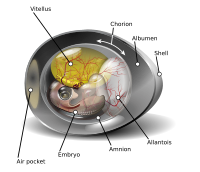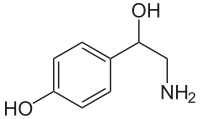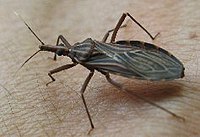
Knockdown of E1‐ and E2‐ubiquitin enzymes triggers defective chorion biogenesis and modulation of autophagy‐related genes in the follicle cells of the vector Rhodnius prolixus
Sign Up to like & getrecommendations! Published in 2022 at "Journal of Cellular Physiology"
DOI: 10.1002/jcp.30806
Abstract: In insects, the last stage of oogenesis is the process where the chorion layers (eggshell) are synthesized and deposited on the surface of the oocytes by the follicle cells. Protein homeostasis is determined by the… read more here.
Keywords: insects; follicle cells; chorion; rhodnius prolixus ... See more keywords

Activity and shelter-related behavior in Rhodnius prolixus: The role of host odours.
Sign Up to like & getrecommendations! Published in 2019 at "Acta tropica"
DOI: 10.1016/j.actatropica.2019.05.022
Abstract: Triatomine bugs are considered nocturnal insects that feed on the blood of vertebrates and remain hidden inside narrow shelters during daylight hours. Nevertheless, it is not clear whether these insects become active and leave their… read more here.
Keywords: host odours; shelter; activity; rhodnius prolixus ... See more keywords

Reverse chemical ecology-based approach leading to the accidental discovery of repellents for Rhodnius prolixus, a vector of Chagas diseases refractory to DEET.
Sign Up to like & getrecommendations! Published in 2018 at "Insect biochemistry and molecular biology"
DOI: 10.1016/j.ibmb.2018.10.004
Abstract: Rhodnius prolixus is one of the most important vectors of Chagas disease in Central and South America for which repellents and attractants are sorely needed. Repellents like DEET, picaridin, and IR3535 are widely used as… read more here.
Keywords: discovery repellents; rhodnius prolixus; reverse chemical; deet ... See more keywords

Changes in antennal gene expression underlying sensory system maturation in Rhodnius prolixus.
Sign Up to like & getrecommendations! Published in 2021 at "Insect biochemistry and molecular biology"
DOI: 10.1016/j.ibmb.2021.103704
Abstract: Triatomine bugs are the blood feeding insect vectors transmitting Chagas disease to humans, a neglected tropical disease that affects over 8 million people, mainly in Latin America. The behavioral responses to host cues and bug… read more here.
Keywords: age; expression; maturation; sensory system ... See more keywords

Behavioral evidence of oxidative stress by hematophagy in the ocellar system of Rhodnius prolixus Stål, 1859 red-eyed mutants.
Sign Up to like & getrecommendations! Published in 2017 at "Journal of insect physiology"
DOI: 10.1016/j.jinsphys.2017.06.011
Abstract: The photonegative response to light stimulation in Rhodnius prolixus (Reduviidae, Triatominae) is modulated by compound eyes and ocelli. Screening pigments in the visual system have been shown to protect the cellular structures from the oxidative… read more here.
Keywords: oxidative stress; red eyed; eyed mutants; rhodnius prolixus ... See more keywords

Cloning, localization, and physiological effects of sulfakinin in the kissing bug, Rhodnius prolixus
Sign Up to like & getrecommendations! Published in 2017 at "Peptides"
DOI: 10.1016/j.peptides.2016.12.017
Abstract: HIGHLIGHTSCloning of the sulfakinin transcript reveals two sulfakinins in Rhodnius prolixus..Rhopr‐SK transcript expression is present in neurons in the brain.Rhopr‐SK‐1 induces contractions of the hindgut in a dose‐dependent manner.Rhopr‐SK‐1 injection decreases the weight of the… read more here.
Keywords: rhodnius prolixus; neurons brain; prolixus; cloning localization ... See more keywords

Trypanosoma rangeli infection increases the exposure and predation endured by Rhodnius prolixus
Sign Up to like & getrecommendations! Published in 2021 at "Parasitology"
DOI: 10.1017/s0031182021001682
Abstract: Trypanosoma rangeli is a protozoan that infects triatomines and mammals in Latin America, sharing hosts with Trypanosoma cruzi, the etiological agent of Chagas disease. Trypanosoma rangeli does not cause disease to humans but is strongly… read more here.
Keywords: trypanosoma rangeli; infection; rhodnius prolixus; rangeli infection ... See more keywords

Atypical strategies for cuticle pigmentation in the blood-feeding hemipteran Rhodnius prolixus.
Sign Up to like & getrecommendations! Published in 2022 at "Genetics"
DOI: 10.1093/genetics/iyac064
Abstract: Pigmentation in insects has been linked to mate selection and predator evasion, thus representing an important aspect for natural selection. Insect body color is classically associated to the activity of tyrosine pathway enzymes, and eye… read more here.
Keywords: tyrosine pathway; color; rhodnius prolixus; cuticle pigmentation ... See more keywords

Dehydration-Stress Resistance in Two Sister, Cryptic Rhodnius Species—Rhodnius prolixus and Rhodnius robustus Genotype I (Hemiptera: Reduviidae)
Sign Up to like & getrecommendations! Published in 2019 at "Journal of Medical Entomology"
DOI: 10.1093/jme/tjz041
Abstract: Abstract Rhodnius prolixus Stål, a major Chagas disease vector, often colonizes in houses, whereas its sister species, Rhodnius robustus Larrousse genotype I, does not colonize in houses and has little medical relevance. Factors potentially underlying… read more here.
Keywords: robustus; dehydration stress; dehydration; rhodnius prolixus ... See more keywords

Developmental roles of tyrosine metabolism enzymes in the blood-sucking insect Rhodnius prolixus
Sign Up to like & getrecommendations! Published in 2017 at "Proceedings of the Royal Society B: Biological Sciences"
DOI: 10.1098/rspb.2016.2607
Abstract: The phenylalanine/tyrosine degradation pathway is frequently described as a catabolic pathway that funnels aromatic amino acids into citric acid cycle intermediates. Previously, we demonstrated that the accumulation of tyrosine generated during the hydrolysis of blood… read more here.
Keywords: metabolism; rhodnius prolixus; developmental roles; tyrosine metabolism ... See more keywords

Using axenic and gnotobiotic insects to examine the role of different microbes on the development and reproduction of the kissing bug Rhodnius prolixus (Hemiptera: Reduviidae)
Sign Up to like & getrecommendations! Published in 2022 at "Molecular Ecology"
DOI: 10.1111/mec.16800
Abstract: Kissing bugs (Hempitera: Reduviidae) are obligately and exclusively blood feeding insects. Vertebrate blood is thought to provide insufficient B vitamins to insects, which rely on obligate symbiotic relationships with bacteria that provision these nutrients. Kissing… read more here.
Keywords: kissing bug; prolixus; insects; rhodnius prolixus ... See more keywords